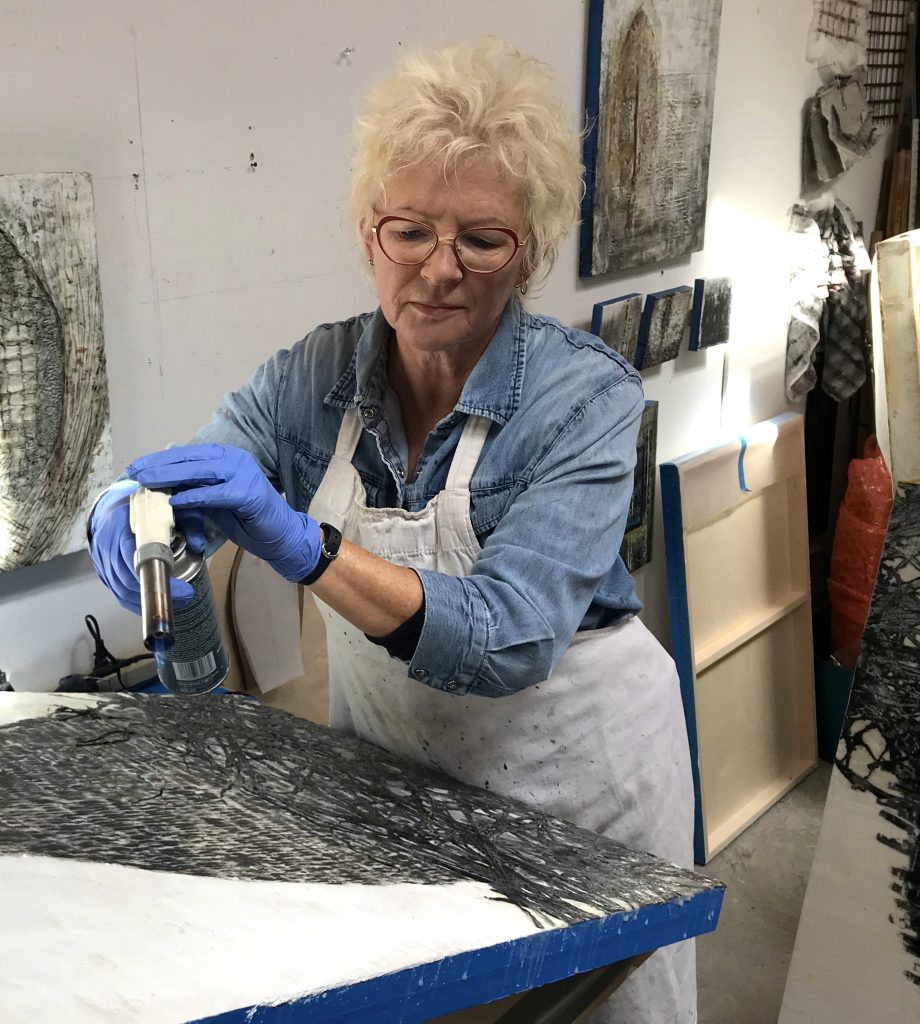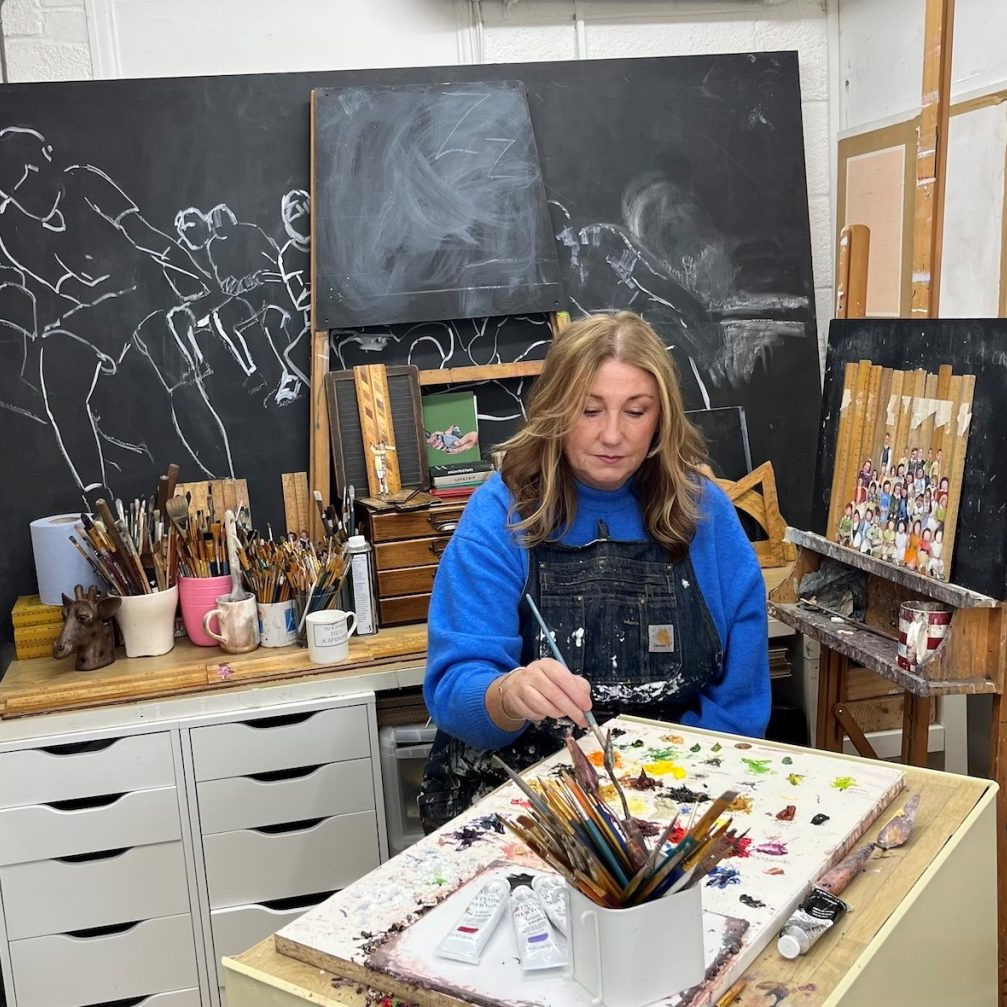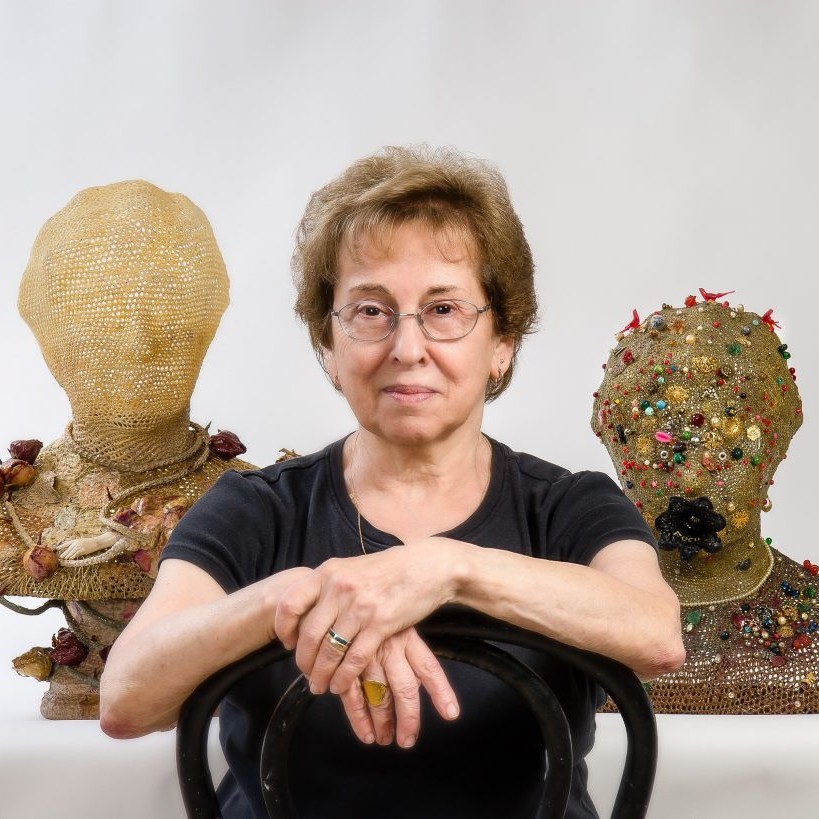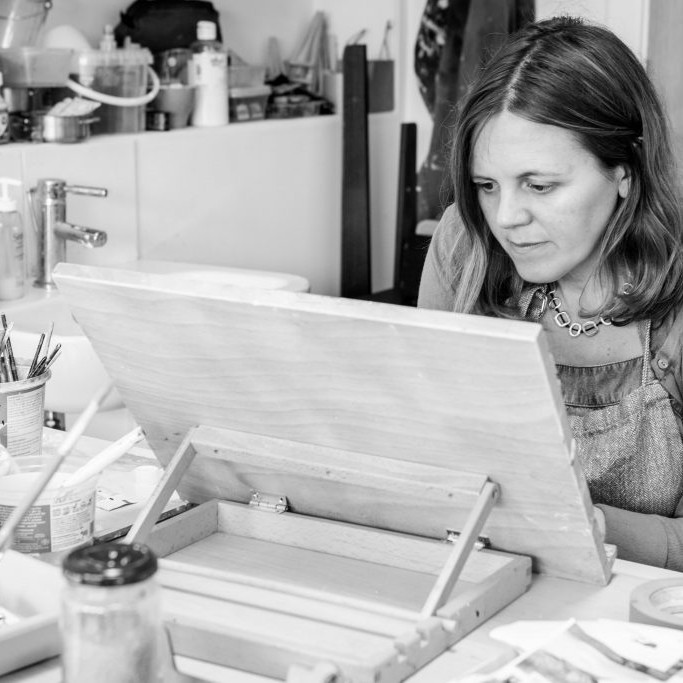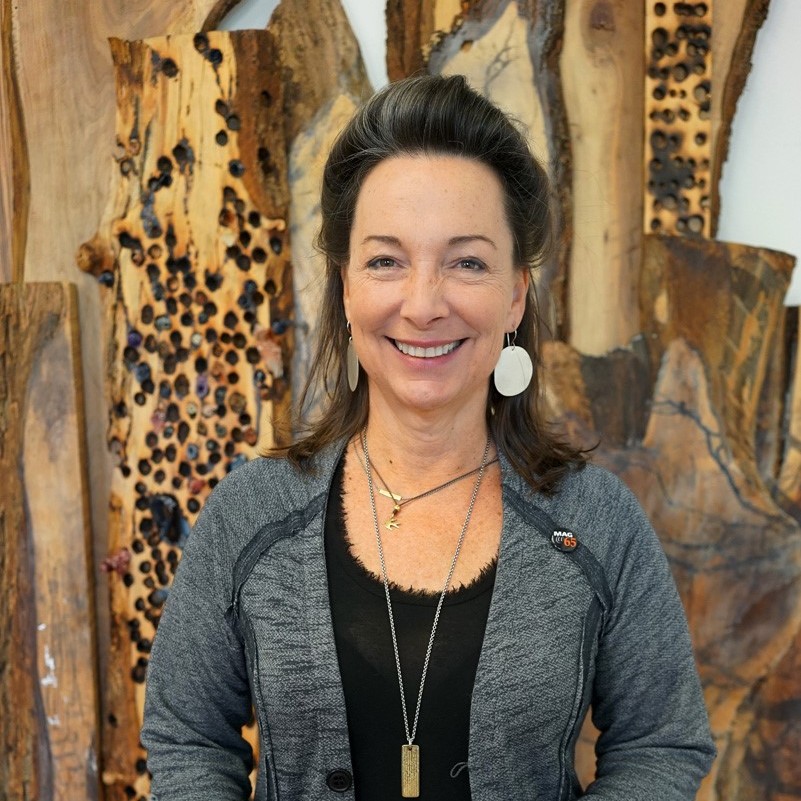Eva Ennist Mixed Media Artist
Can you explain about your residency at Tartu?
Your personal background with Estonia
Your mother’s working gloves
How these two aspects influenced your residency?
I was drawn to attending the Tartu Artist in Residency program in Estonia because my parents were Estonian, my life and work experiences deeply connected to this heritage. Both parents were incredibly hard working, creative and very frugal and my mother introduced me to making things from scratch, recycling and reusing. She had a DYI mentality long before the sustainability movement was a thing.
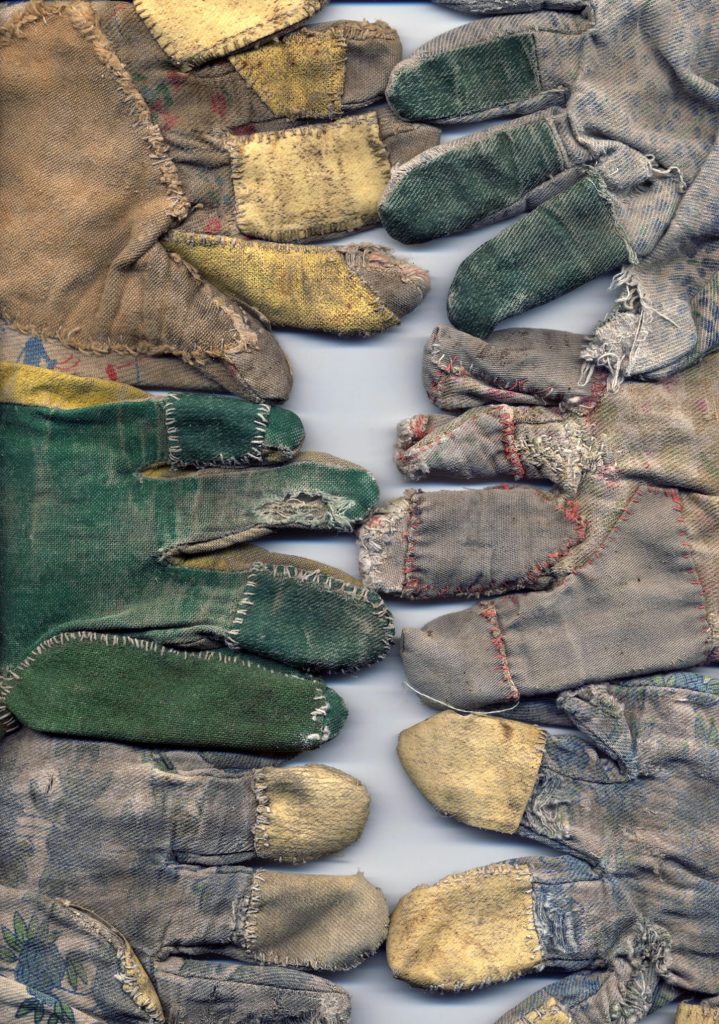
Mother’s working gloves prepped for collagraph print
My residency project was inspired by a collection of dozens of my mother’s old work gloves. Gloves that she had repaired and rebuilt many times, over many years from parts of other worn out gloves. Her commitment to getting every last bit of use out of any material or object was awe-inspiring. But in her final years, as dementia set in, it was also troubling to see this otherwise commendable frugality turn into an obsession with collecting and hoarding – a behaviour I suspect was rooted in her wartime experiences of making do with very little.
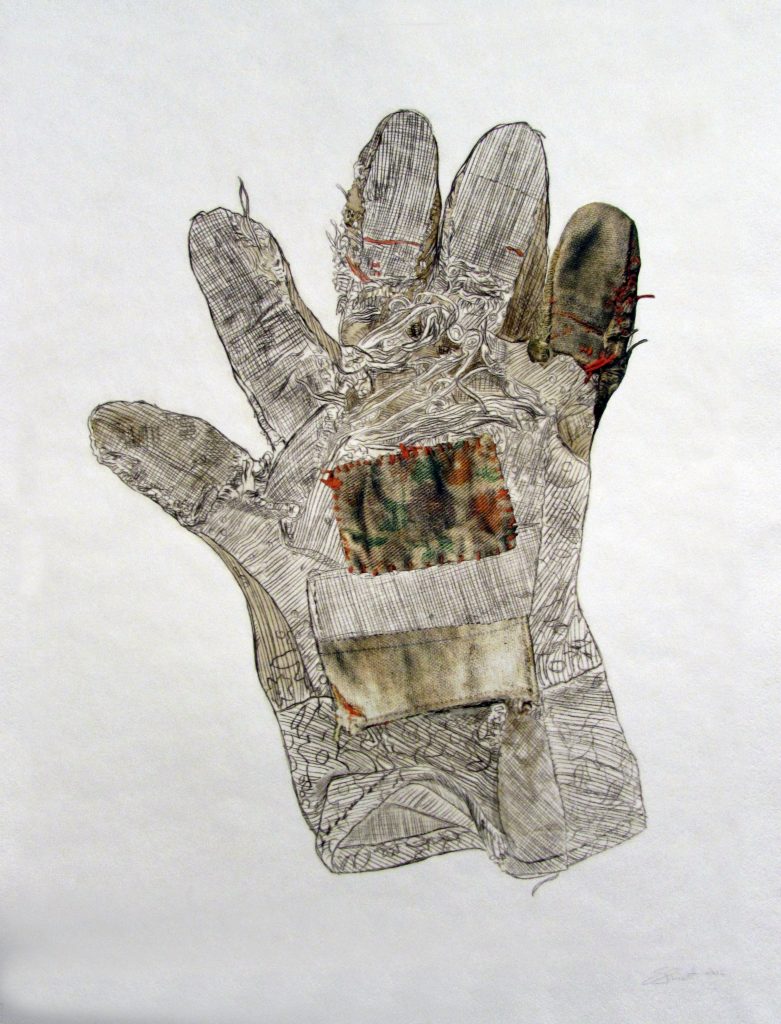
Resumed Repair #5, Drypoint print, digital print collage, 63.5 x 50.8cm
While in Tartu at the Estonian Print and Paper Museum, I worked with collagraph printed textile imagery, dry point etchings and the digitally printed enlargements of the actual gloves that I had brought from Canada. This exploration resulted in various collaged pieces that refer to my mother’s tireless work ethic and survival instincts – as well as to my own drive to sustain an art practice based on reusing and repurposing both materials and meaning.
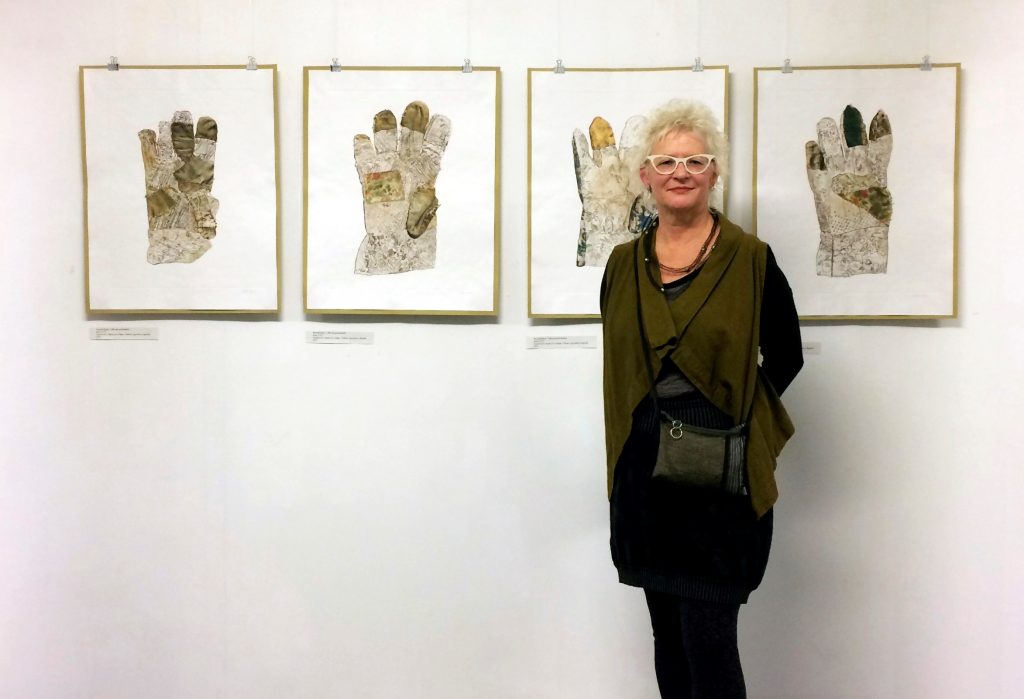
Tartuensis Gallery Opening
How important is travel and photography in your work?
I believe that travel to places near and far will only continue to amaze, bewilder, excite and inspire me and my art making practice.
At 20 years of age I took my very first trip abroad to Barcelona, Spain where I was able to climb up inside one of Antoni Gaudi’s incredible Sagrada Familia Basilica spires (they were permanantly closed to the public soon after). I found the experience breathtaking, both literally and artistically. Little did I know then that it would be an inspiration in my work to this day. Those shapes, as spires or temples, are one of many such architectural structures that reappear in my sculptures and encaustic /mixed media works.
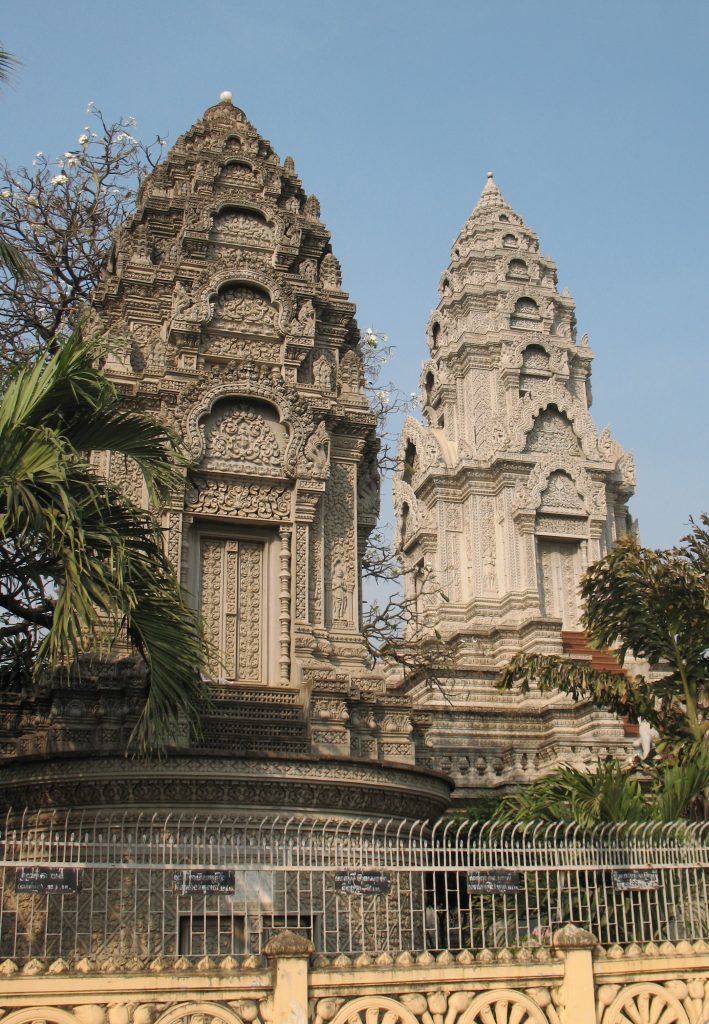
Temple in India
Photography plays an integral part of expressing the experience of the places that I have travelled to. I document cultural sites, awe-inspiring landscapes as well as close-up details of design, art and craft found in unexpected locations and objects. I take countless images of man-made temple spires, baskets, traps and woven grids in landscapes. But often what I find more inspirational are various bird nests, spider webs and termite mounds – architecture created instinctively by animals.
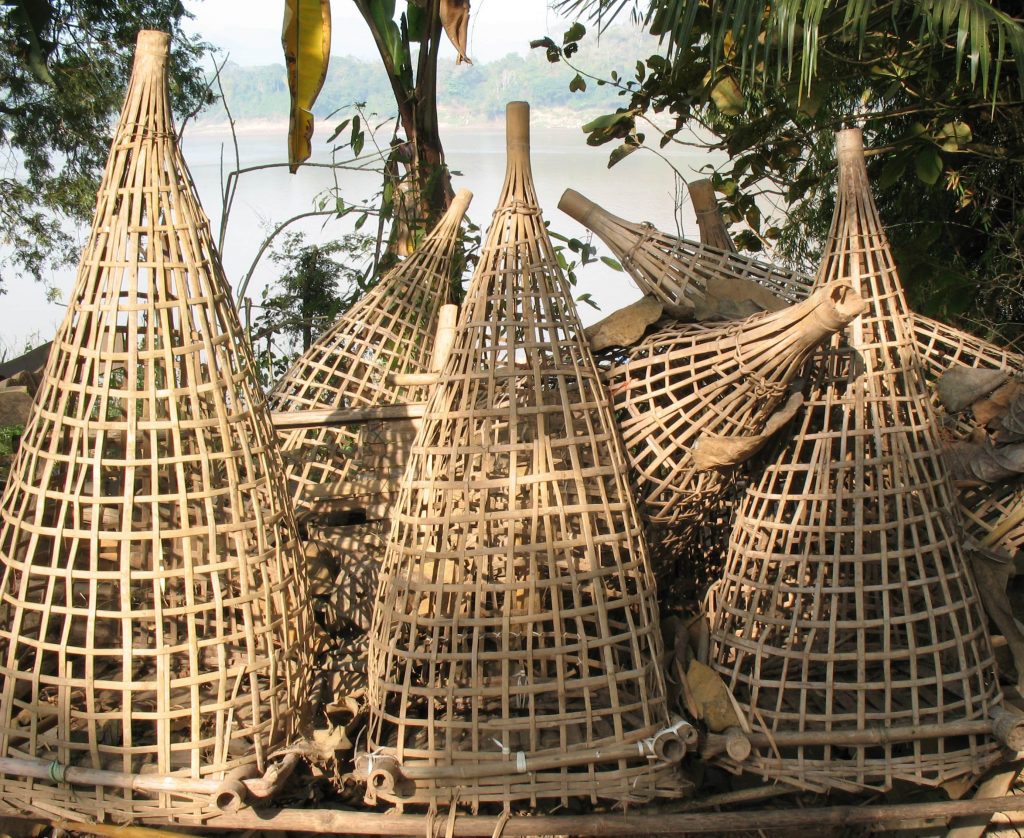
Fishing baskets in Laos
These images may develop and materialize as sculptural objects made of wire, reed, bamboo, concrete and handmade paper.
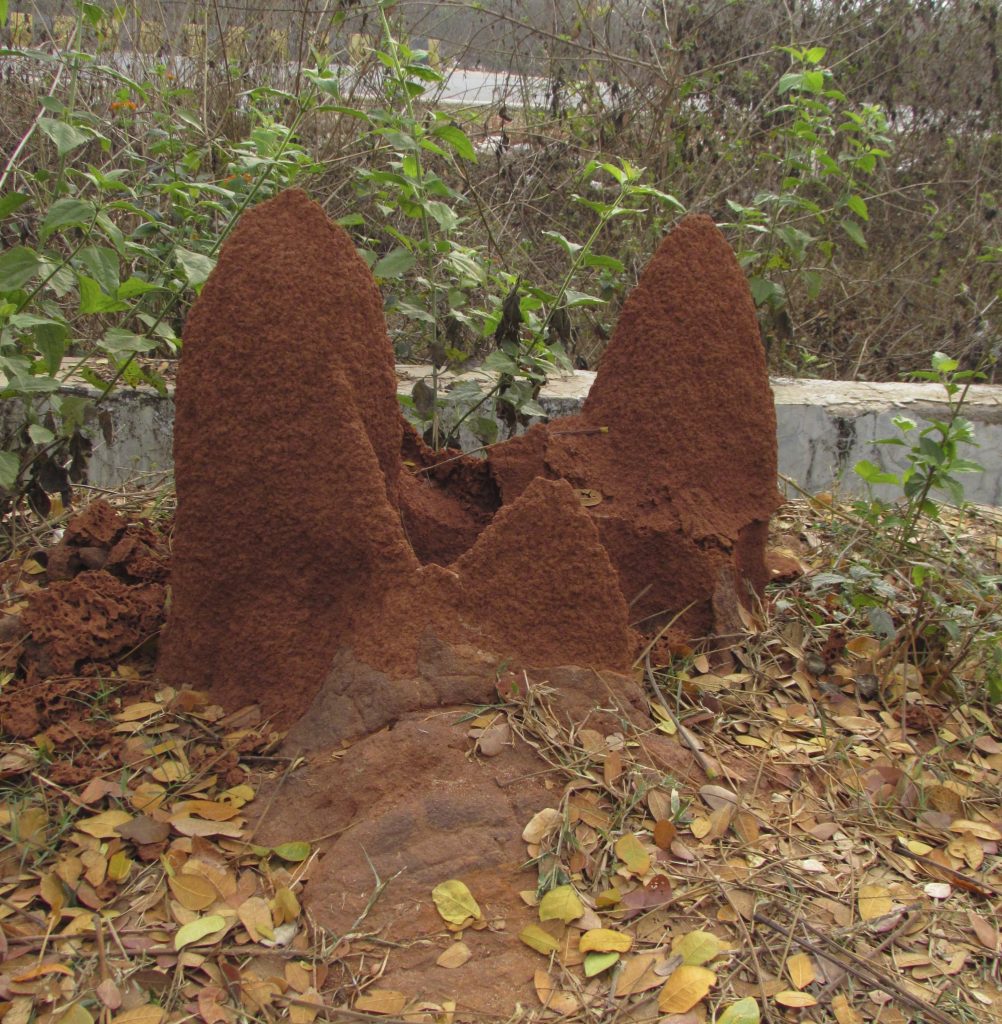
Termite nests in Bhubaneswar, India
Photographs of the actual sculptures are often manipulated and find their way into the many layers of my encaustic paintings. The photo is transferred by fusing it to the wax medium creating a base image or recognizable texture.
Expand on your series, ‘Uncanny Resemblance’
Techniques you have used
The importance of found objects
the use of adding only single colour to specific works
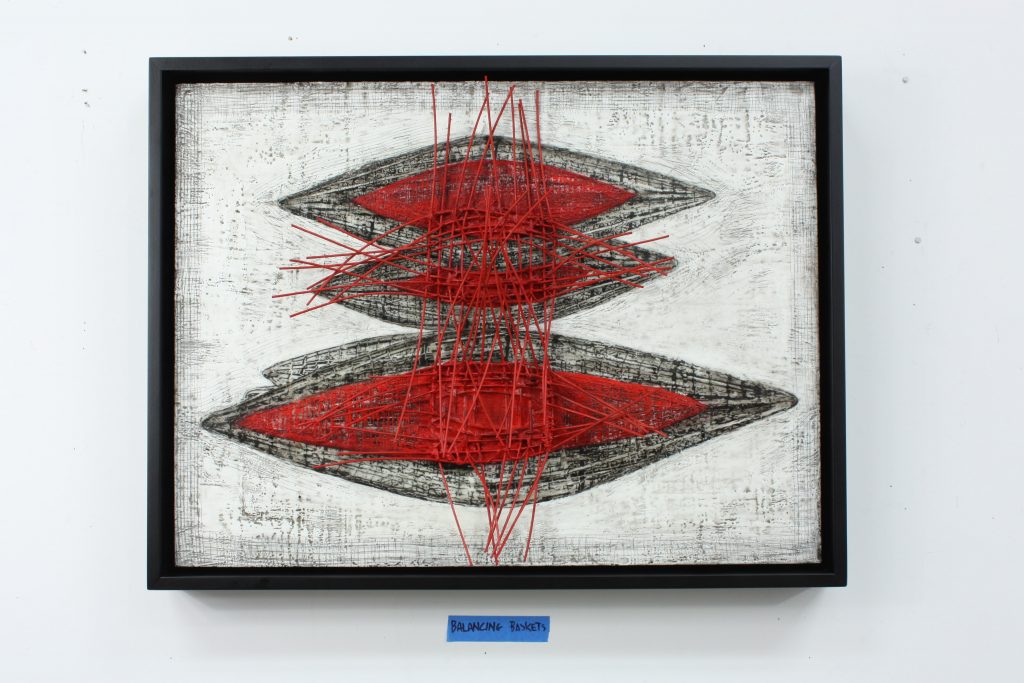
Balancing Baskets, Encaustic and mixed media, 46 x 61cm
For the exhibition, “Uncanny Resemblance”, all 50 wall pieces were encaustic paintings/mixed media works of various sizes. The mixed media elements include small, coiled, wire cones, flattened wire grids coated with paper pulp, scraps of window screening or woven reed structures imbedded into thick layers of encaustic medium (which is made of beeswax, damar resin and pigment). I also fused transfers of drawings and photographs from a preceeding series of sculptures.
This process of borrowing imagery and textures from older pieces allows new bodies of work to continue to relate to what came prior and to inform what may develop next.
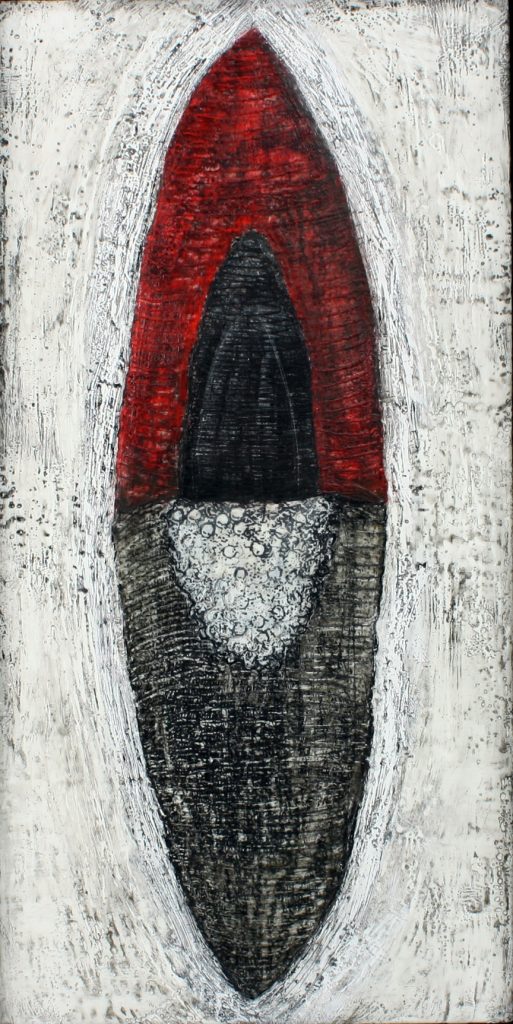
Black Lotus Budding, Encaustic and mixed media, 61 x 30.5cm
Discuss, size in your work using ‘Nesting’
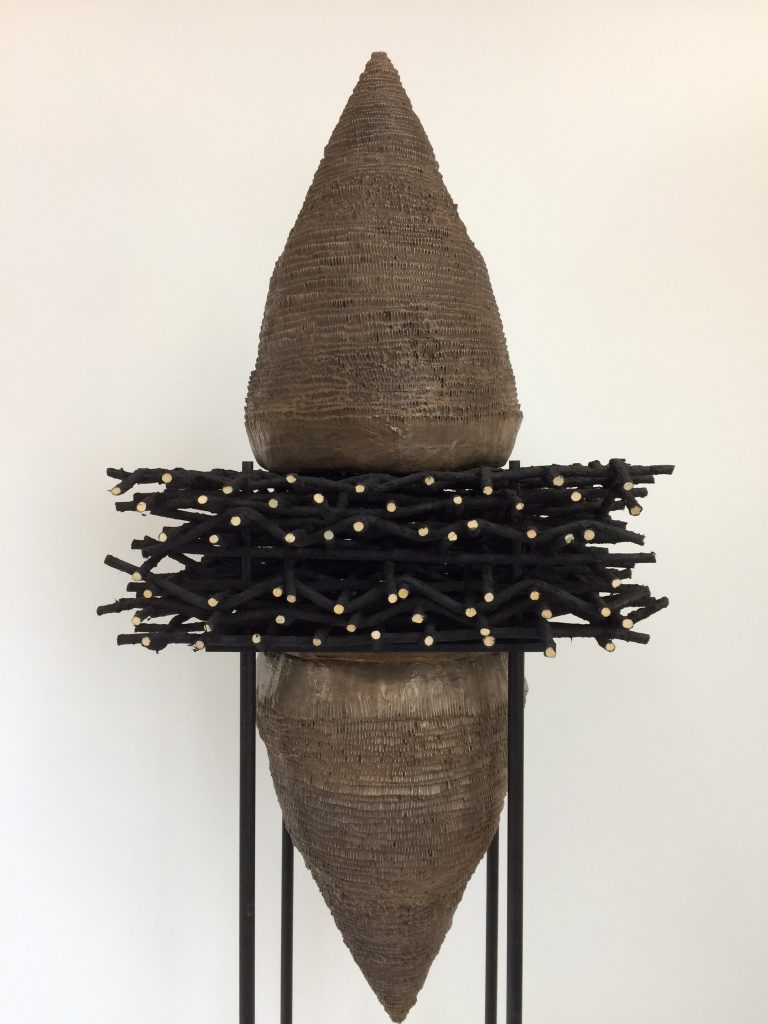
Nesting Hold, Reed, Wood, steel, abaca, cast resin, paint, 213 x 40.85 x 40.85cm
My sculptures range from small table pieces to fairly tall structures. Even though I refer to the five sculptures in the “Nesting” series as human scale, they are mounted on 33 cm high bases taking on an almost towering presence when up close.
The size of the larger sculptures I create is dictated by the size of the woven reed grids. These interlaced layers were once part of much bigger panels for previous sculpture installations. Once cut, these smaller grids can be manipulated in many different configurations.
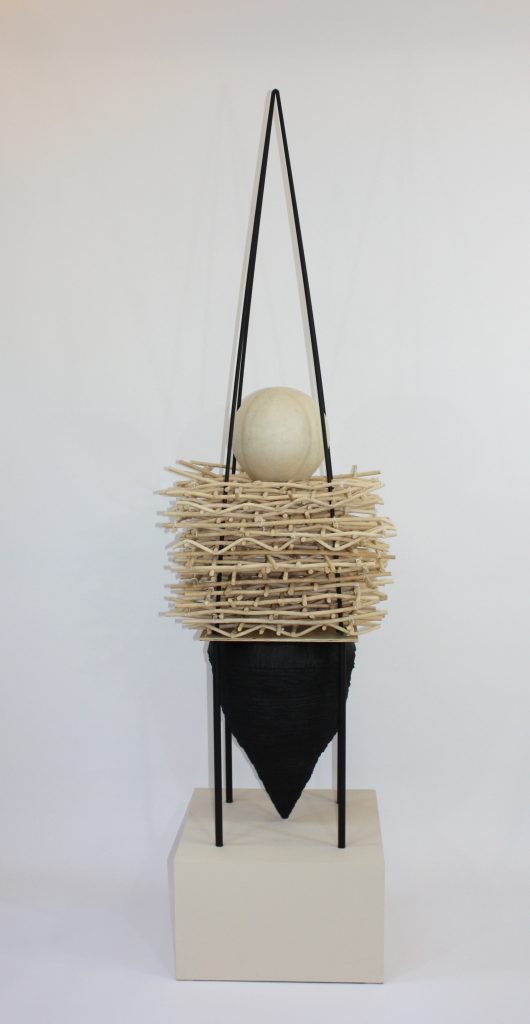
Nesting Tolerance, reed, cold cast bronze, wood, steel, paint, 195.5 x 54.25 x 54.25cm
Most elements of all, of my larger sculptures come apart so that I am able to get them out of my studio – a very real problem.
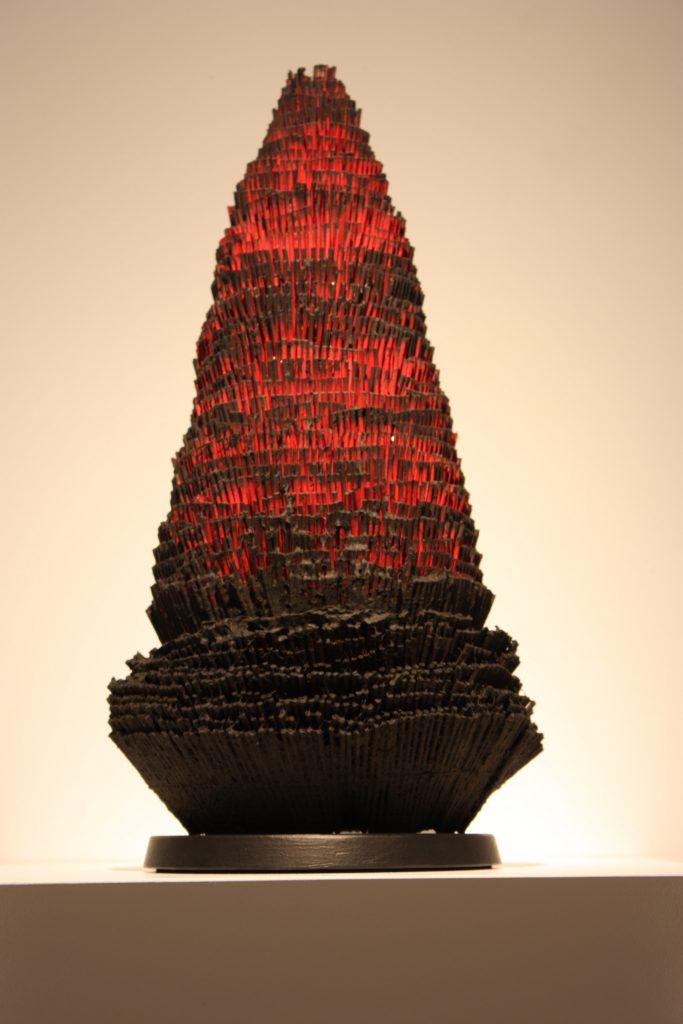
Nesting Lotus #6, Bamboo, handmade paper, concrete, 43.2 x 22.8cm
Take 1 or 2 specific materials that you have found and developed into your sculptures, discuss.
Many of my sculptures and encaustic mixed media works are made with natural reed, also known as the core of rattan. It is a pliable, dyeable vine when processed comes in diameters 2 mm to 30 mm. I have woven it into grid structures, sprayed it with paper pulp, embedded it into concrete forms, and into layers of encaustic wax medium. I have also created large installations, light sculptures and even a balcony railing with this textile-like material.
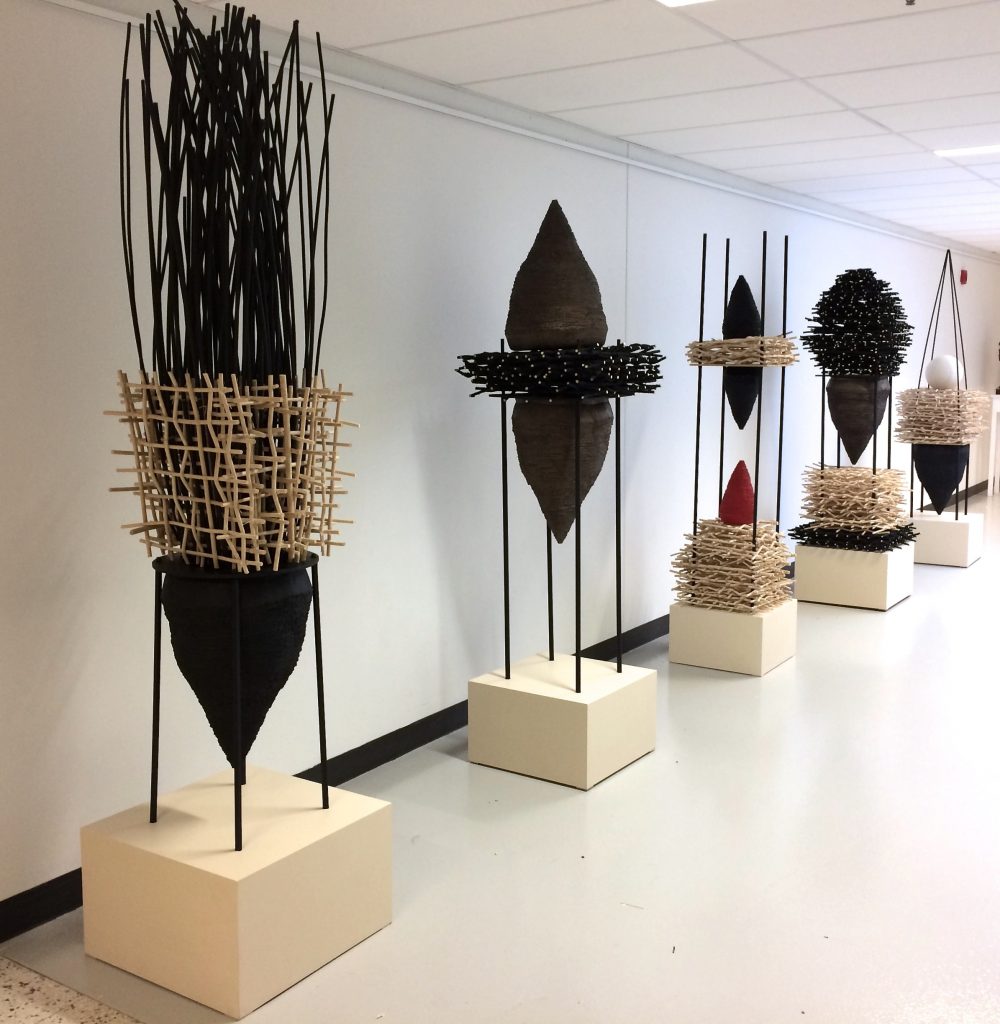
Nesting installation view at World of Threads Exhibition, 2018
Other frequently used but non-fibre materials that I work with are wire mesh and “hardware cloth”. Several years ago, I discovered 5 cm wide strips of this metal cloth that were being thrown out at a wire company here in Toronto. I salvaged several rolls and eventually began to coil the strips, forming them into very sturdy conical shapes. The grids overlapped allowing some very dense areas and other very open sections. I often created a “skin” by spraying hand made paper partially covering the cone. That was the foundation for many sculptures and two dimensional works over the last 22 years.
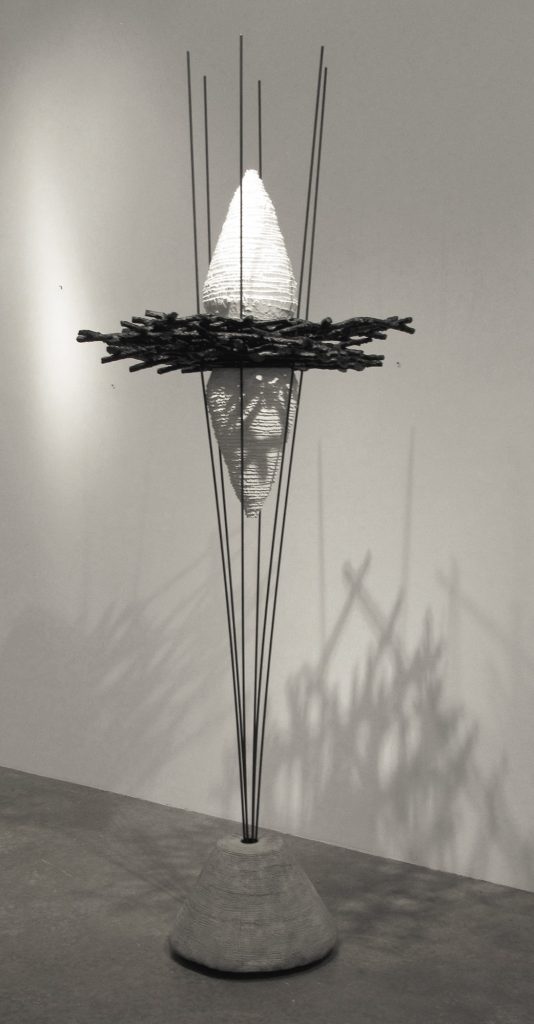
Potential, Concrete, steel, cast resin, reed, 183 x 35.5cm
How has sight and the actual eye charts become a part of your work?
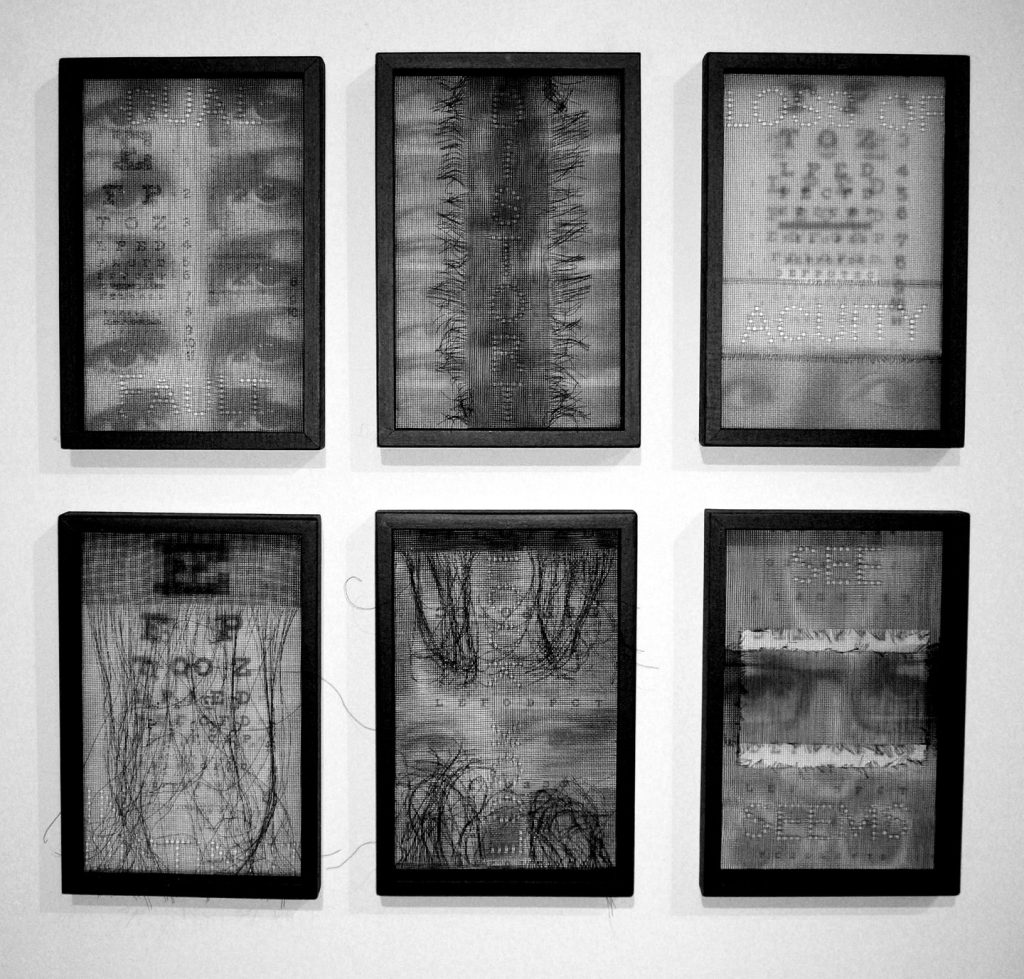
Eye chart series, wire mesh, digital photo, each 30 x 20cm
My family has had inherent eye problems for many years. Not only the run of the mill myopia and astigmatism but also glaucoma, retinal tears and detachment, cataracts and night blindness have been a on-going problem.
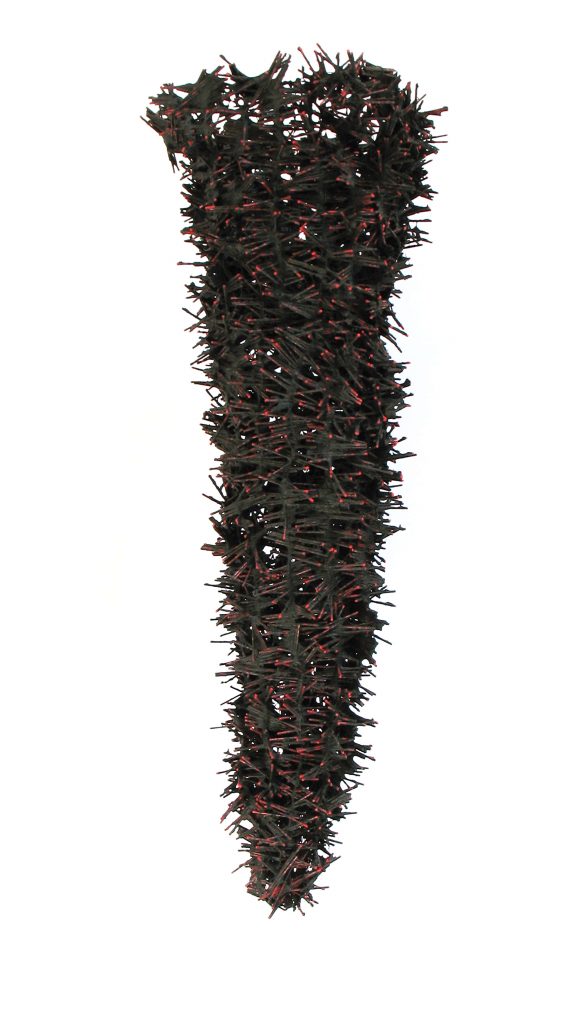
Blunted Sight #1, Bamboo, thread, wire, abaca paper pulp, 82 x 25cm
It seemed inevitable that I would delve into the capacity of sight and I have come across terms such as distortion, simultaneity, clarity that are fundamental in the language of vision as are anatomical references to cones and rods (the light sensitive cells in the retina of the eye). At the same time, these concepts could also be applied to human capabilities beyond the physiological such as concentration and focus.
I began to experiment with layering, assembling, sometimes ‘blurring’ images of the standard eye chart, my own eyes and related text. Textiles, hand made paper, wire mesh, digital embroidery and print were materials for both 2 and 3 dimensional compositions.
Mona – Give us your thoughts on using known art work as a basis of new art.
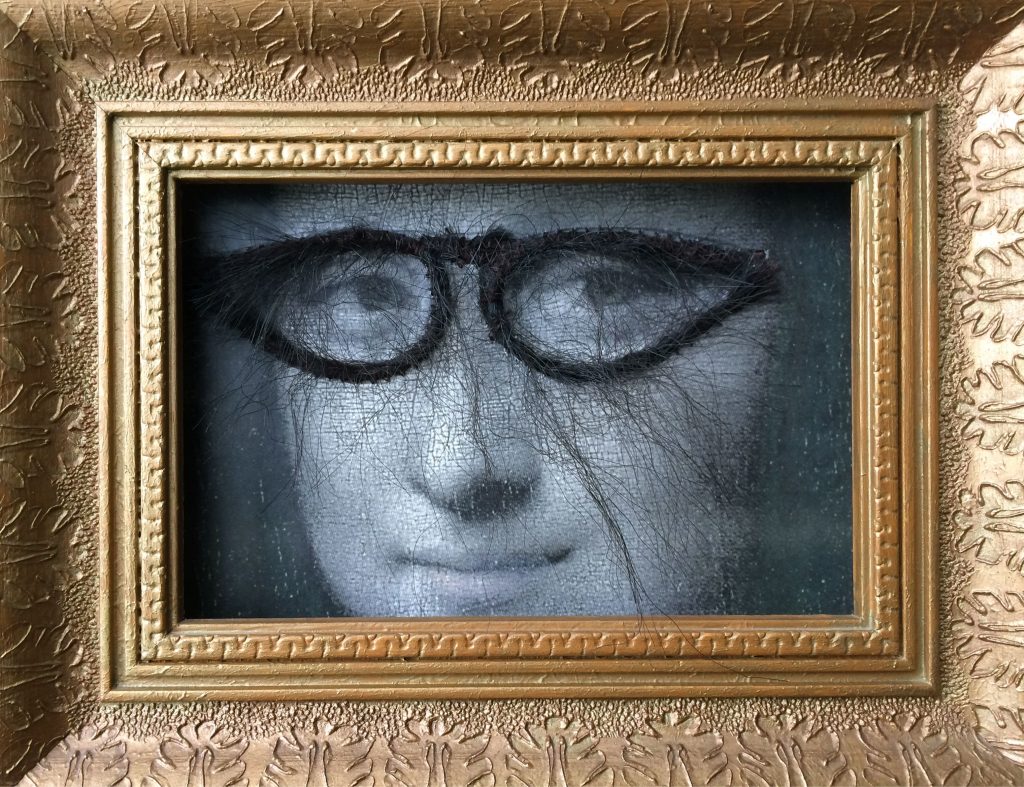
The Hairy Eye, photo transfer, fabric, artificial hair, thread, 22 x 17cm
If the artwork appropriated is designated “public domain” or an artist has considerably transformed the original artwork of another then I’m open to the work being used in essence as a “material”.
Using images of famous artworks like DaVinci’s Mona Lisa elicits an immediate recognition of the subject matter. This painting has been parodied by countless artists, designers and art directors for years for various effects – usually with comedic twist. This was one part of why I first started to “play” with Mona’s image. The other part was the fact that my favourite uncle/godfather had nicknamed me Mona Lisa (my full name is Eva-Lisa) when I was a small child. He travelled the world for his work and once brought back for me an incredible porcelain doll, which I named Mona Lisa. She was my favourite doll.
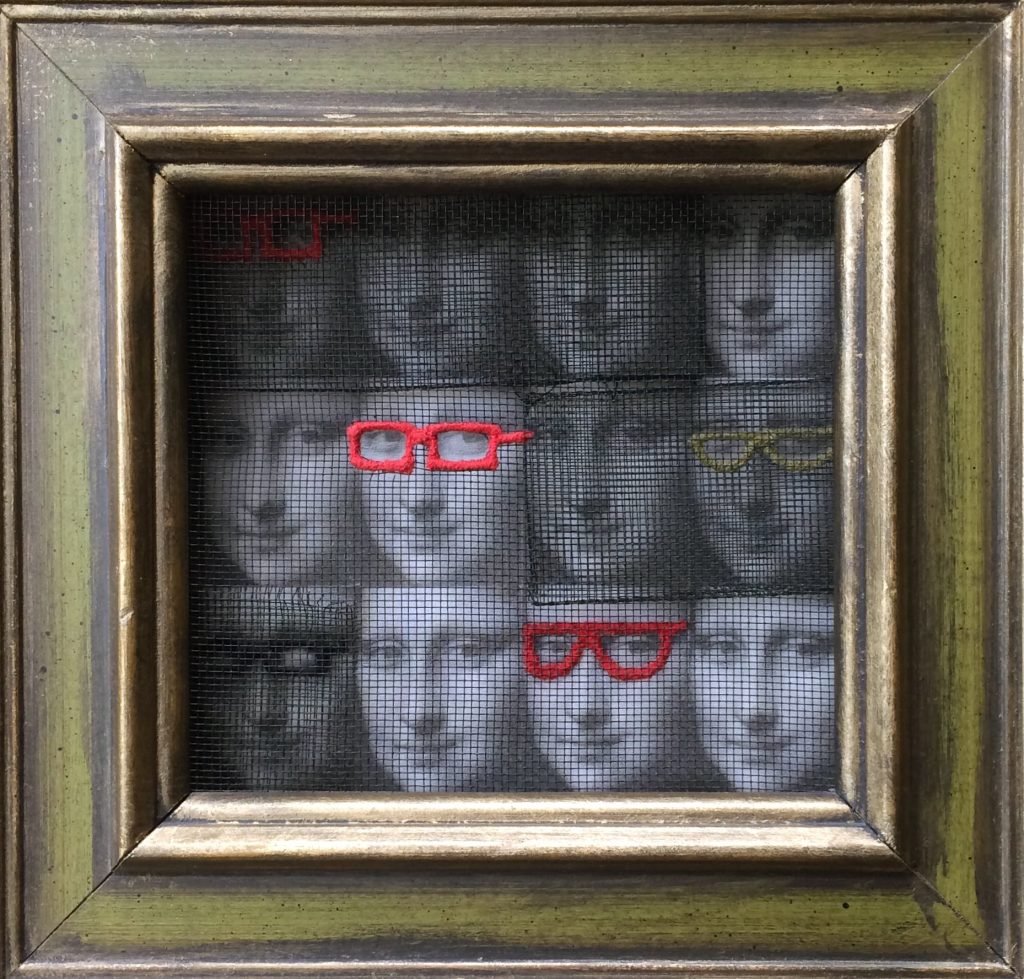
Emigmatic / Stigmatic 2, photo transfer, fabric, thread, wire mesh, 29 x 28cm
How have you manipulated Mona Lisa – use 2 or 3 works to explain this?
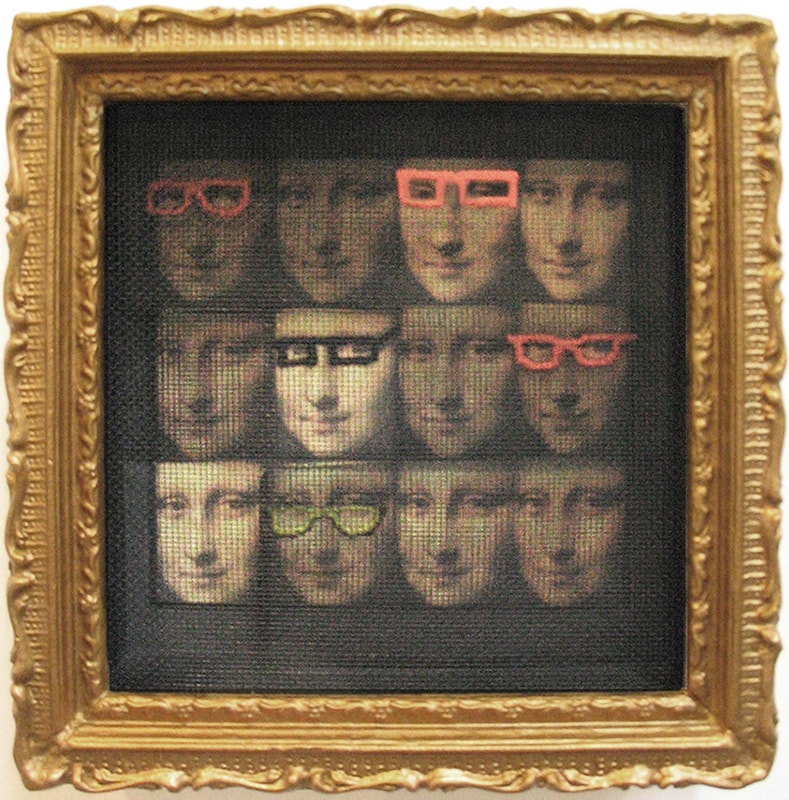
Myopic Mona, Photo transfer, fabric, thread, wire mesh, 20 x 20cm
While I was working with visual impairment as a serious concept for my work, I had also started creating collages where people or animals were wearing spectacles. I started cutting and pasting eyeglasses from magazines on all sorts of people and animals. This was initially for my own amusement – they were silly and I was able to do them while travelling. In the studio I took this a step further and started to applique fake hair onto singular images of Mona Lisa (The Hairy Eye #1) which had been photo transferred to fabric. This hair was sewn in the shape of eyeglasses. I decided to use multiple Mona Lisa images in one piece and machine embroidered eyeglasses with colourful thread onto a layer of window screening and mounted the piece in an ornate gold frame. This piece, titled Myopic Mona, sold for the highest bid at a fundraiser auction. It seemed I had hit a nerve. So I continued with this approach.
You have been practicing art for 40 years can you discuss your personal thoughts on how your art has changed and developed?
Actually, I have been making art professionally since graduating from art school over 43 years ago. I began to teach, travel and study abroad about 5 years into my practice.
For the first 10 years after school, the main focus of my work was textiles, specifically tapestry weaving for exhibition and corporate and residential commissions. Most of my designs came from looking at the natural world from very close up or from within. My sketchbooks were full of details of insects, diagrams of fossils and watercolours of plants growing out of rock crevices and geological cross sections. As tapestry weaving was very slow (especially pieces that were 9.3 sq metres in size) I felt the need to experiment with other, more immediate fibre techniques to express my ideas. I took a couple of courses in papermaking and never looked back. This new approach using hand made paper pulp and sheet form allowed me to embed and cast familiar woven elements such as mesh, gauze, and plaited reed to create wall pieces and sculptural forms.
Photo imagery seeped into the mix as well when the work took on a more sobering path after my father passed away late 1989. Personal mourning was expressed along side of loss and preservation practised by women of various cultures.
As time passed, the parallels of death and sleep became the theme of both 2 and 3 dimensional sculpture and installations. However, as the work progressed so did the emphasis of the eyes in a closed position gradually led to the investigation of the faculty of sight, with the eyes wide open. Perception, sight and insight are words that conjure up experiences and memories common to many – I was very interested in conveying this in mixed media (handmade paper, woven reed, photo imagery, wire mesh).
As this process was developing, in 1993 I was invited to join a team of architects and other craft based artists to create a large installation called Designed by Commission: Collaboration 1993 for IIDEX, Interior Design Show. My contribution was a two-layered canopy of thick woven reed and handmade paper pulp suspended over a ceramic, wood and glass platform installation. The creation of these 122 cm x 244 cm panels was the start of a series of large works using the same size and format for many exhibitions and installations.
But after a few years of storing these interesting and “still useful” materials, I decided to recycle the panels by cutting them into smaller sections for various other sculptures.
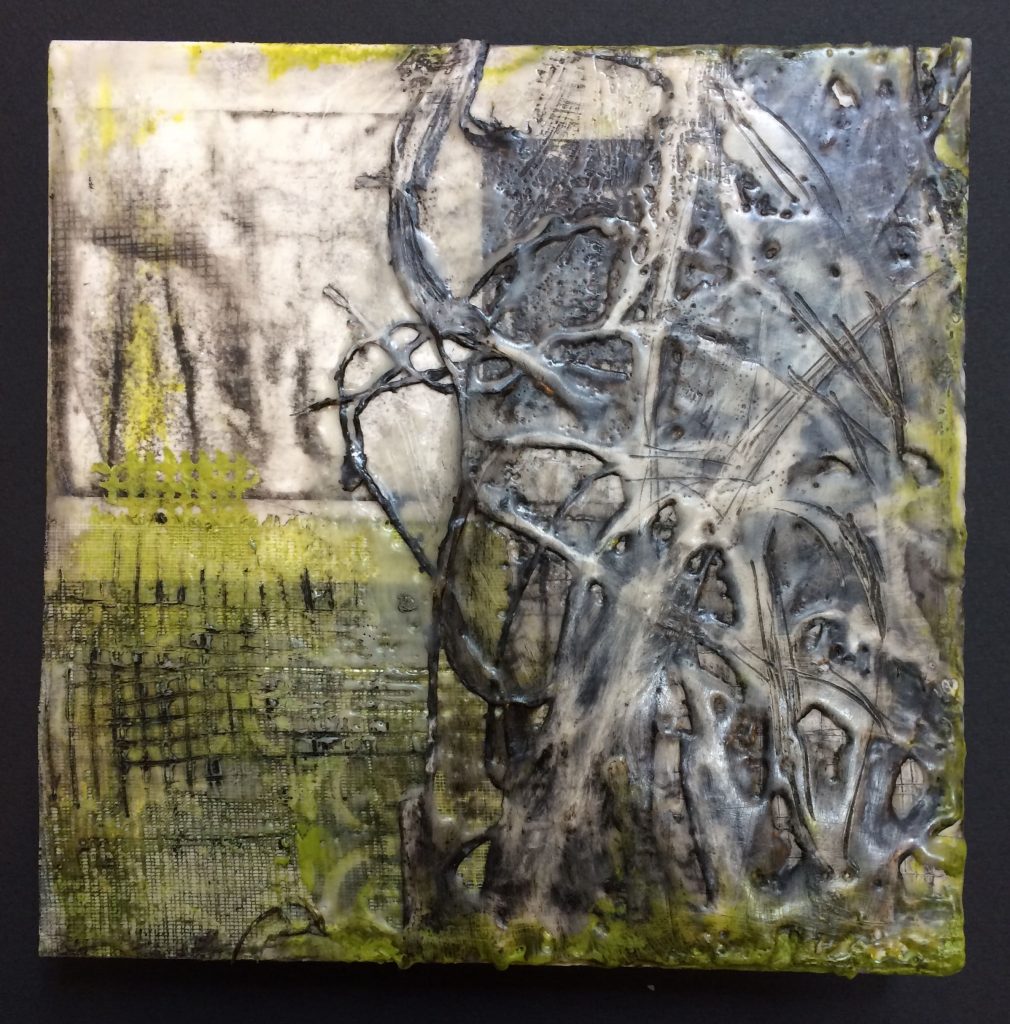
Untitled new work, encaustic and mixed media, 25.5 x 25.5cm
A few years ago, I was introduced to using textiles and mixed media in encaustic painting by a wonderful artist, Daniella Woolf. After taking a few courses and much experimentation, this approach has allowed me to develop many of my ideas in uncanny ways.
Your work is in many private and public collections, take one or two pieces that have given your great pride and why?
I have mixed feelings about this question. Through the years, many of the commissions, sales or exhibitions have been meaningful achievements in their time and place. But I can honestly say that none of them stands out beyond the others because each one is an affirmation of what I am doing as an artist. I think that just keeping at it, committing to taking risks, challenging myself with new techniques, materials and concepts in the studio and beyond is what I am most proud of. Plus knowing that for over 30 years I contributed to the art education of hundreds of students, which gives me great satisfaction.
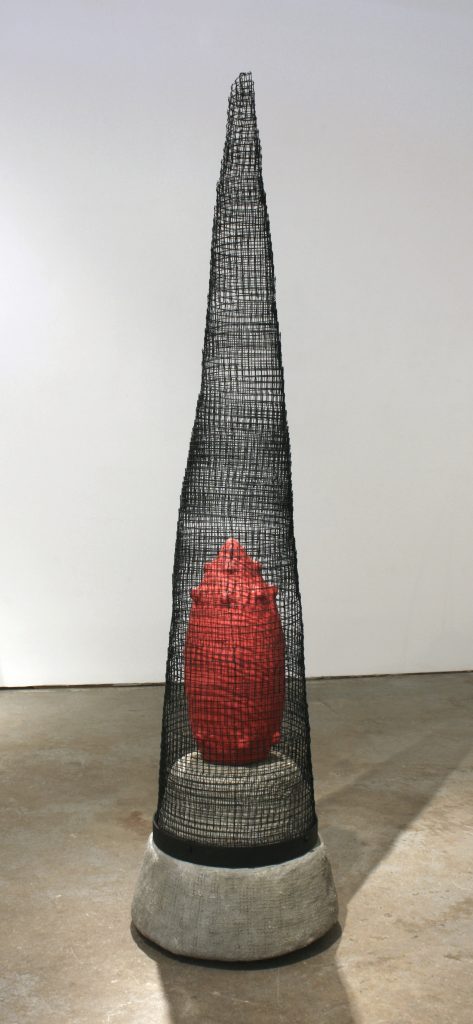
Safe, steel mesh, concrete, 155 x 35.5cm
Contact:
Eva Ennist
Email :
Deborah Blakeley, Melbourne, Australia
Interview by Deborah Blakeley, November 2019
Think a colleague or friend could benefit from this interview?
Knowledge is one of the biggest assets in any business. So why not forward this on to your friends and colleagues so they too can start taking advantage of the insightful information the artist has given?
Other artists you may be interested in:


